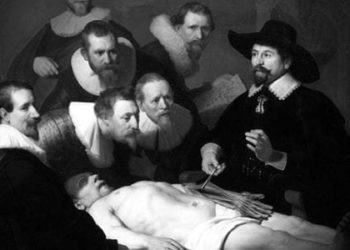Magnesium sulfate in torsade de pointes [Classics Series]
Image: PD
1. Intravenous magnesium sulfate was effective at acutely terminating torsade de pointes.
2. Intravenous magnesium sulfate was not effective in terminating other ventricular tachycardias not associated with QT prolongation.
Original Publication: February 1988
Study Rundown: Torsade de pointes (TdP) is distinguished from other forms of ventricular tachycardia (VT) due to its occurrence in patients with marked QT prolongation. Because of this underlying difference, torsade de pointes is found to be responsive to intravenous (IV) magnesium sulfate (MgSO4), while other forms of ventricular tachycardias are not. This article is the first case-series demonstrating the effect of MgSO4 on terminating torsade de pointes.
After the publication of this article, MgSO4 became the standard therapy for treatment of TdP. The study is rudimentary and did not employ complicated statistics, but it did have intriguing findings – all twelve subjects with TdP responded to MgSO4 and none of the 5 non-TdP VT subjects did. Weaknesses of the study include low sample size (N=17) and significant non-controlled-for variability in patients’ demographics, cardiac history and function, baseline electrolyte levels, as well as concurrent therapy. Furthermore, no individual data is shown for the 5 non-TdP subjects.
In summary, despite the many weaknesses of the paper by today’s standards, the paper plays an important role in cardiology and helped establish MgSO4 as standard practice in treating TdP.
Click to read the study in Circulation
In-Depth [case-series study]: This study is the first study of its kind that explored MgSO4 treatment in patients with TdP and patients who had other forms of ventricular tachycardia. The study consisted of 12 patients with TdP and 5 patients with polymorphous VT with normal QT interval, who were treated with 25% or 50% solutions of MgSO4 and were observed for termination of arrhythmia and recurrence. The mean QT interval was 0.61s in the TdP group (mean QTc of 0.64s) and 0.46s (mean QTc not provided) in the non-TdP VT group. Magnesium levels prior to onset of arrhythmia were available for 8/12 TdP patients and 2/5 non-TdP VT patients and were all within normal limits (1.6-2.5 meq/L). Two out of 12 patients had potassium levels below 3.1 meq/L (both were 2.9 meq/L). No non-TdP VT patient had potassium levels below 3.1 meq/L.
Two grams of IV MgSO4 bolus were administered to all 12 TdP and 5 non-TdP subjects as soon as arrhythmia was recognized. Four of the TdP patients received other modes of therapy, which were not effective, prior to MgSO4 therapy. Nine patients responded immediately to the MgSO4. The other 3 patients received a 2nd bolus within 5-15 minutes and were started on a continuous infusion. In two patients, the TdP recurred 1-6 hours after infusion was begun and was abolished in both after a 3rd bolus of IV MgSO4. MgSO4 infusion was continued until QT<0.50s. Two of the 12 patients had elevated magnesium levels (3.5 and 5 meq/L) after treatment with MgSO4. Zero out of the 5 non-TdP VT patients showed improvement with MgSO4 therapy even after 2-3 boluses. Three of the five patients responded to other IV antiarrhythmics (2 to lidocaine, 1 to procainamide).
©2012-2014 2minutemedicine.com. All rights reserved. No works may be reproduced without expressed written consent from 2minutemedicine.com. Disclaimer: We present factual information directly from peer reviewed medical journals. No post should be construed as medical advice and is not intended as such by the authors, editors, staff or by 2minutemedicine.com. PLEASE SEE A HEALTHCARE PROVIDER IN YOUR AREA IF YOU SEEK MEDICAL ADVICE OF ANY SORT.

![The ABCD2 score: Risk of stroke after Transient Ischemic Attack (TIA) [Classics Series]](https://www.2minutemedicine.com/wp-content/uploads/2013/05/web-cover-classics-with-logo-medicine-BW-small-jpg-350x250.jpg)
![Adverse pregnancy outcomes associated with thrombophilias [Classics Series]](https://www.2minutemedicine.com/wp-content/uploads/2015/07/Classics-2-Minute-Medicine-e1436017941513-350x250.png)




